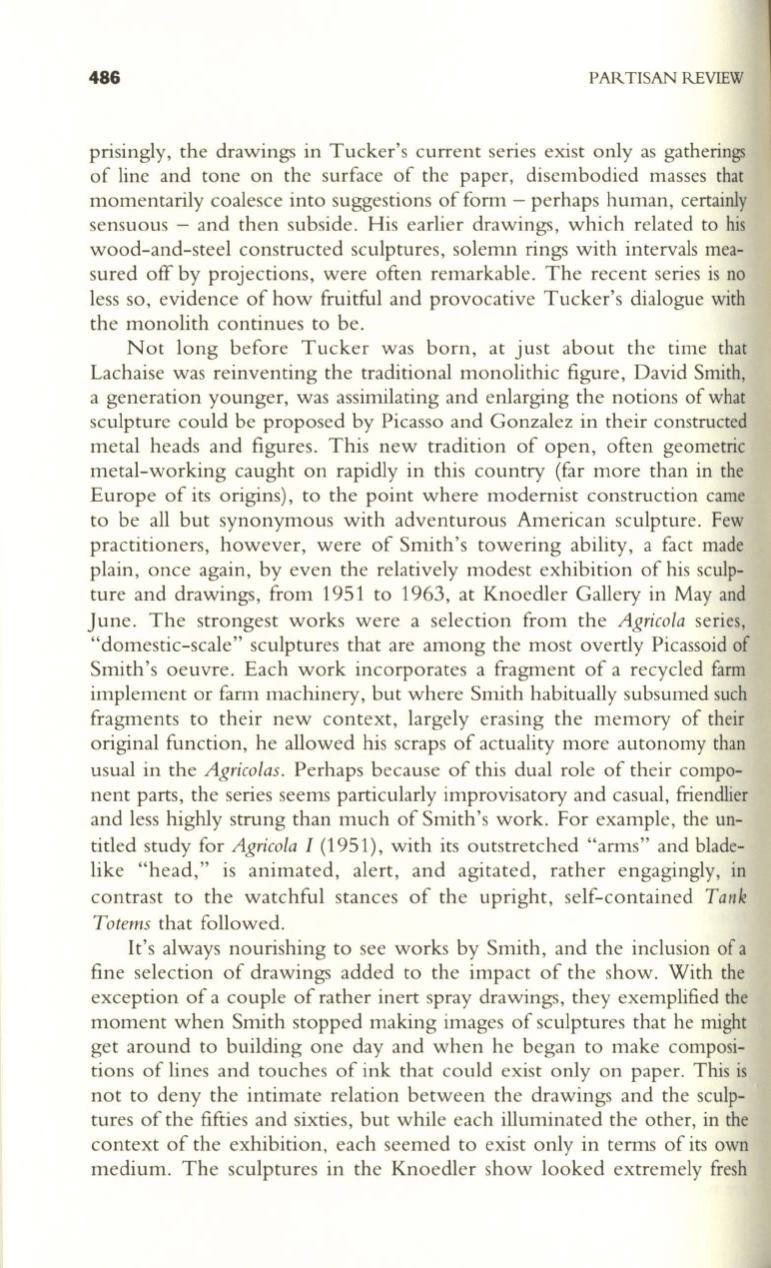
486
PARTISAN REVrEW
prisingly, the drawings in Tucker's current series exist only as gatherings
of line and tone on the surface of the paper, disembodied masses that
momentarily coalesce into suggestions of form - perhaps human, certainly
sensuous - and then subside. His earlier drawings, which related to his
wood- and-steel constructed sculptures, solemn rings with intervals mea–
sured off by projections, were often remarkable. The recent series is no
less so, evidence of how fruitful and provocative Tucker's dialogue with
the monolith continues to be.
Not long before Tucker was born, at just about the time that
Lachaise was reinventing the traditional monolithic figure, David Smith,
a generation younger, was assimilating and enlarging the notions of what
sculpture could be proposed by Picasso and Gonzalez in their constructed
metal heads and figures. This new tradition of open, often geometric
metal-working caught on rapidly in this country (far more than in the
Europe of its origins), to the point where modernist construction came
to be all but synonymous with adventurous American sculpture. Few
practitioners, however, were of Smith's towering ability, a fact made
plain, once again, by even the relatively modest exhibition of his sculp–
ture and drawings, from 1951 to 1963, at Knoedler Gallery in May and
June. The strongest works were a selection from the
Agricola
series,
"domestic- scale" sculptures that are among the most overtly Picassoid of
Smith's oeuvre . Each work incorporates a fragment of a recycled farm
implement or farm machinery, but where Smith habitually subsumed such
fragments to their new context, largely erasing the memory of their
original function, he allowed his scraps of actuality more autonomy than
usual in the
Agricolas.
Perhaps because of this dual role of their compo–
nent parts, the series seems particularly improvisatory and casual, friendlier
and less highly strung than much of Smith's work. For example, the un–
titled study for
Agricola I
(1951), with its outstretched "arms" and blade–
like "head," is animated, alert, and agitated, rather engagingly, in
contrast to the watchful stances of the upright, self- contained
Tank
Totems
that followed.
It's always nourishing to see works by Smith, and the inclusion of a
fine selection of drawings added to the impact of the show. With the
exception of a couple of rather inert spray drawings, they exemplified the
moment when Smith stopped making images of sculptures that he might
get around to building one day and when he began to make composi–
tions of lines and touches of ink that could exist only on paper. This is
not to deny the intimate relation between the drawings and the sculp–
tures of the fifties and sixties, but while each illuminated the other, in the
context of the exhibition, each seemed to exist only in terms of its own
medium. The sculptures in the Knoedler show looked extremely fresh


